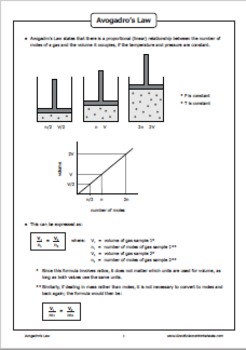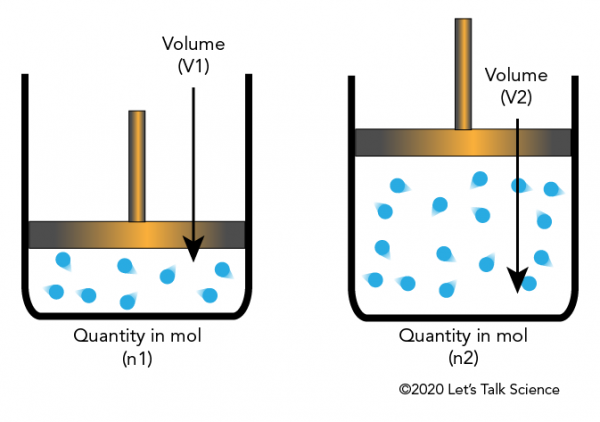The molar volume is close to 22.4 liters (22.4 dm 3) for virtually all gases. That equal volumes of gases at the same temperature and pressure contain equal numbers of molecules was first suggested in 1811 by the Italian chemist Amadeo Avogadro (1776 to 1856). Consequently it is called Avogadro’s law or Avogadro’s hypothesis. Avogadro's Law states that the volumes of ideal gases are proportional to the number of molecules that are present in the gas (or the number of moles in the gas). I've been trying to find out more about it, but I can't seem to find out why this holds true, at least for ideal gases. The molar volume is close to 22.4 liters (22.4 dm 3) for virtually all gases. That equal volumes of gases at the same temperature and pressure contain equal numbers of molecules was first suggested in 1811 by the Italian chemist Amadeo Avogadro (1776 to 1856). Consequently it is called Avogadro’s law or Avogadro’s hypothesis. Avogadro’s Law Avogadro’s Law is one of the gas laws. At the beginning of the 19th century, an Italian scientist Lorenzo Romano Amedeo Carlo Avogadro studied the relationship between the volume and the amount of substance of gas present. The results of certain experiments with gases led him to formulate a well-known Avogadro’s Law.
- where:
- V is the volume of the gas.
- n is the amount of substance of the gas.
- k is a proportionality constant.
Avogadro’s law also means the ideal gas constant is the same value for all gases, so:
constant = p1V1/T1n1 = P2V2/T2n2
V1/n1 = V2/n2
V1n2 = V2n1 Rms usb devices driver download.

where p is the pressure of a gas, V is volume, T is temperature, and n is number of moles
Examples of Avogadro’s law in Real Life Applications
- As you blow up a football, you are forcing more gas molecules into it. The more molecules, the greater the volume. The basketball inflates.
- As you blow up a balloon, you are forcing more gas molecules into the balloon which would increase the balloon volume and cause them to balloon inflate.
- A flat tire takes up less space than an inflated tire, because it contains less air.
Charles' Law
Charles' law states that, at a constant pressure, the volumeof a mixed amount of gas is directly proportional to its absolute temperature:
Where k is a constant unique to the amount of gas and pressure. Just as with Boyle's law, Charles' law can be expressed in its more useful form:
| = |
The subscripts 1 and 2 refer to two different sets of conditions, just as with Boyle's law.
Why must the temperature be absolute? If temperature is measured on a Celsius (non absolute) scale, T can be negative. If we plug negative values of T into the equation, we get back negative volumes, which cannot exist. In order to ensure that only values of V≥ 0 occur, we have to use an absolute temperature scale where T≥ 0. The standard absolute scale is the Kelvin(K) scale. The temperature in Kelvin can be calculated via Tk = TC + 273.15. A plot of the temperature in Kelvin vs. volume gives :As you can see from , Charles' law predicts that volume will be zero at 0 K. 0 K is the absolutely lowest temperature possible, and is called absolute zero.
Avogadro's Law
Avogadro's law states that the volume of a gas at constant temperature and pressure is directly proportional to the number of moles of gas present. It's mathematical representation follows:
k is a constant unique to the conditions of P
 and T. n is the number of moles of gas present.
and T. n is the number of moles of gas present.1 mole (mol) of gas is defined as the amount of gas containing Avogadro's number of molecules. Avogadro's number (NA) is
| NA = 6.022×1023 |
1 mol of any gas at 273 K (0_C) and 1 atm has a volume of 22.4 L. The conditions 273 K and 1 atm are the standard temperature and pressure (STP). STP should not be confused with the less common standard atmospheric temperature and pressure (SATP), whichcorresponds to a temperature of 298 K and a pressure of 1 bar.
The numbers 22.4 L, 6.022×1023, and the conditions of STP should be near and dear to your heart. Memorize them if you haven't already.
The Ideal Gas Law
Charles', Avogadro's, and Boyle's laws are all special cases of the ideal gas law:

T must always be in Kelvin. n is almost always in moles.
Avogadro's Law Chemistry
RAvogadro's Gas Law Calculator
is the gas constant. The value of R depends on the units of P, V and n. Be sure to ask your instructor which values you should memorize.| Units | Value of R |
| 0.08206 | |
| 8.314 | |
| 8.314 | |
| 1.987 | |
| 62.36 |
The ideal gas law is the equation you must memorize for gases. It not only allows you to relate P, V, n and T, but can replace any of the three classical gas laws in a pinch. For example, let's say you're given constant values of P and n, but forget how Charles' law relates V and T. Rearrange the ideal gas law to separate the constants and unknowns:
Voila!
 We have derived Charles' law from the ideal gas law.
We have derived Charles' law from the ideal gas law.  n, R, and T are constants, so is just the constant k from Charles' law.
n, R, and T are constants, so is just the constant k from Charles' law.The ideal gas law is also useful for those rare occasion when you forget the value of a constant. Logitech g gaming software download. Let's say I forgot the value of R in . If I remember that a mole of gas has a volume of 22.4 L at STP (760 torr, 273 K), I can rearrange PV = nRT to solve for R in the desired units. It is much more efficient to memorize the values, but it is comforting to know that you can always fall back on good old PV = nRT.
Applying the Ideal Gas Law
Ideal gas law problems tend to introduce a lot of different variables and numbers. The sheer amount of information can be confusing, and it is wise to develop a systematic method to solve them:
1) Jot down the values of P, V, n, and T. If the question says that one of these variables is constant or asks you to find the value of one or the other, make a note of it. Every time you encounter a numerical value or variable, try to fit it into your PV = nRT scheme.
2) Rearrange PV = nRT such that the unknowns and knowns are on opposite sides of the '=' sign. Make sure that you are comfortable with the algebra involved.
Is physical therapy covered by blue cross blue shield. Co-pay for physical therapy sessions. Jln0720 over 4 years ago. An independent company that provides and hosts an online community platform for blogging and access to social media for Blue Cross and Blue Shield of Illinois. File is in portable document format (PDF). To view this file, you may need to install a PDF reader program. Physical (PT), Occupational (OT) & Speech Therapy: $25 Physical Therapy and Occupational Therapy $15 Speech Therapy: Hospital Choice Cost Share — Save up to 16 percent off current costs. Blue Cross Blue Shield of Massachusetts is an Independent Licensee of the Blue Cross and Blue Shield Association. 2020 Blue Cross and Blue Shield Service Benefit Plan - FEP Blue Focus Section 5(a). Medical Services and Supplies Provided by Physicians and Other Healthcare Professionals Note: The calendar year deductible applies to almost all benefits in this Section. We say '(No deductible)' when it does not apply.
3) Convert to the appropriate units. Generally you'll want to deal with SI units (m3, Pa, K, mol). There will be times that non-SI units will be more convenient. In these cases, remember that T must always be in Kelvin. Make sure to select the correct value and units of R.
4) Plug in values and solve for the unknown(s). Ideal gas problems involve a great deal of algebra. The only way to master this type of problem is to practice. Use the problems provided at the end of this section and your textbook until the manipulations of PV = nRT become familiar.
5) Take a step back and check your work. The easiest way to do this is to carry all of the units through your ideal gas calculations. When you're about to solve the equation, make sure that the units on both sides of the '=' sign are equivalent. For simpler problems, it is also worthwhile to make sure that your answer makes sense. For example, if n, R, and T are constant and Prises, make sure that V decreases. It only takes a few seconds, and can save you from some embarrassing mistakes. The usefulness of such commonsense checks decreases as the questions get more complex. For any problem where more than two variables change, you're better off trusting the ideal gas law and your own algebra.
The best advice I can give you is to practice. The more problems you do, the more comfortable you will be with the ideal gas law.
